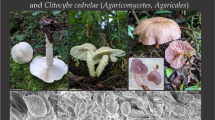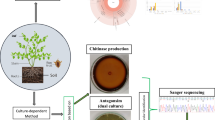Abstract
Two novel actinomycetes, designated strains NEAU-ZJ3T and NEAU-yn31T, were isolated from soils in China and their taxonomic positions determined by a polyphasic approach. Key morphological and chemotaxonomic properties of the two strains were consistent with the description of the genus Nonomuraea. The G+C contents of strains NEAU-ZJ3T and NEAU-yn31T were determined to be 67.4 and 68.0 %, respectively. Phylogenetic analysis using 16S rRNA gene sequences indicated that the two strains should be classified in the genus Nonomuraea. The 16S rRNA gene sequence of strain NEAU-ZJ3T showed it to be most closely related to Nonomuraea salmonea DSM 43678T (98.27 %), Nonomuraea endophytica YIM 65601T (98.23 %) and Nonomuraea candida HMC10T (98.08 %), and that of strain NEAU-yn31T to Nonomuraea ferruginea IFO 14094T (99.08 %) and N. candida HMC10T (98.01 %). Furthermore, a combination of DNA–DNA hybridization results and some phenotypic characteristics indicated that the two strains can be distinguished from each other and their phylogenetically closest relatives. Thus, strains NEAU-ZJ3T and NEAU-yn31T represent two novel species of the genus Nonomuraea, for which the names Nonomuraea guangzhouensis sp. nov. and Nonomuraea harbinensis sp. nov. are proposed. The type strains are NEAU-ZJ3T (=CGMCC 4.7101T = DSM 45889T) and NEAU-yn31T (=CGMCC 4.7106T = DSM 45887T), respectively.


Similar content being viewed by others
References
Camas M, Sazak A, Spröer C, Klenk H-P, Cetin D, Guven K, Sahin N (2013) Nonomuraea jabiensis sp. nov., isolated from arid soil. Int J Syst Evol Microbiol 63:212–218
Cao YR, Jin RX, Jiang Y, He WX, Jiang CL (2012) Nonomuraea soli sp. nov., an actinomycete isolated from soil. Int J Syst Evol Microbiol 62:1587–1591
Collins MD (1985) Isoprenoid quinone analyses in bacterial classification and identification. In: Goodfellow M, Minnikin DE (eds) Chemical methods in bacterial systematics. Academic Press, London, pp 267–284
De Ley J, Cattoir H, Reynaerts A (1970) The quantitative measurement of DNA hybridization from renaturation rates. Eur J Biochem 12:133–142
Felsenstein J (1981) Evolutionary trees from DNA sequences: a maximum likelihood approach. J Mol Evol 17:368–376
Felsenstein J (1985) Confidence limits on phylogenies: an approach using the bootstrap. Evolution 39:783–791
Gordon RE, Barnett DA, Handerhan JE, Pang C (1974) Nocardia coeliaca, Nocardia autotrophica, and the nocardin strain. Int J Syst Bacteriol 24:54–63
Hayakawa M, Nonomura H (1987) Humic acid–vitamin agar, a new medium for the selective isolation of soil actinomycetes. J Ferment Technol 65:501–509
Huss VAR, Festl H, Schleifer KH (1983) Studies on the spectrometric determination of DNA hybridisation from renaturation rates. Syst Appl Microbiol 4:184–192
Kämpfer P, Busse HJ, Tindall BJ, Nimtz M, Grün-Wollny I (2010) Nonomuraea rosea sp. nov. Int J Syst Evol Microbiol 60:1118–1124
Kelly KL (1964) Inter-society color council-national bureau of standards color-name charts illustrated with centroid colors published in US
Kim SB, Brown R, Oldfield C, Gilbert SC, Iliarionov S, Goodfellow M (2000) Gordonia amicalis sp. nov., a novel dibenzothiophene–desulphurizing actinomycete. Int J Syst Evol Microbiol 50:2031–2036
Kim OS, Cho YJ, Lee K, Yoon SH, Kim M, Na H, Park SC, Jeon YS, Lee JH, Yi H, Won S, Chun J (2012) Introducing EzTaxon-e: a prokaryotic 16S rRNA gene sequence database with phylotypes that represent uncultured species. Int J Syst Evol Microbiol 62:716–721
Kimura M (1980) A simple method for estimating evolutionary rates of base substitutions through comparative studies of nucleotide sequences. J Mol Evol 16:111–120
Kroppenstedt RM, Stackebrandt E, Goodfellow M (1990) Taxonomic revision of the actinomycete genera Actinomadura and Microtetraspora. Syst Appl Microbiol 13:148–160
Lechevalier MP, Lechevalier HA (1970) Chemical composition as a criterion in the classification of aerobic actinomycetes. Int J Syst Bacteriol 20:435–443
Lechevalier MP, Lechevalier HA (1980) The chemotaxonomy of actinomycetes. In: Dietz A, Thayer DW (eds) Actinomycete taxonomy special publication, vol 6. Society of Industrial Microbiology, Arlington, pp 227–291
Lechevalier MP, De Bièvre C, Lechevalier HA (1977) Chemotaxonomy of aerobic actinomycetes: phospholipid composition. Biochem Syst Ecol 5:249–260
Li J, Zhao GZ, Huang HY, Zhu WY, Lee JC, Xu LH, Kim CJ, Li WJ (2011) Nonomuraea endophytica sp. nov., an endophytic actinomycete isolated from Artemisia annua L. Int J Syst Evol Microbiol 61:757–761
Mandel M, Marmur J (1968) Use of ultraviolet absorbance temperature profile for determining the guanine plus cytosine content of DNA. Methods Enzymol 12B:195–206
McKerrow J, Vagg S, McKinney T, Seviour EM, Maszenan AM, Brooks P, Seviou RJ (2000) A simple HPLC method for analysing diaminopimelic acid diastereomers in cell walls of Gram-positive bacteria. Lett Appl Microbiol 30:178–182
Minnikin DE, Hutchinson IG, Caldicott AB, Goodfellow M (1980) Thin-layer chromatography of methanolysates of mycolic acid-containing bacteria. J Chromatogr 188:221–233
Minnikin DE, O’Donnell AG, Goodfellow M, Alderson G, Athalye M, Schaal A, Parlett JH (1984) An integrated procedure for the extraction of bacterial isoprenoid quinones and polar lipids. J Microbiol Methods 2:233–241
Nakaew N, Sungthong R, Yokota A, Lumyong S (2012) Nonomuraea monospora sp. nov., an actinomycete isolated from cave soil in Thailand, and emended description of the genus Nonomuraea. Int J Syst Evol Microbiol 62:3007–3012
Nonomura H, Ohara Y (1971) Distribution of actinomycetes in soil. XI. Some new species of the genus Actinomadura Lechevalier et al. J Ferment Technol 49:904–912
Quintana E, Maldonado L, Goodfellow M (2003) Nonomuraea terrinata sp. nov., a novel soil actinomycete. Antonie Van Leeuwenhoek 84:1–6
Saitou N, Nei M (1987) The neighbor-joining method: a new method for reconstructing phylogenetic trees. Mol Biol Evol 4:406–425
Shirling EB, Gottlieb D (1966) Methods for characterization of Streptomyces species. Int J Syst Bacteriol 16:313–340
Smibert RM, Krieg NR (1994) Phenotypic characterization. In: Gerhardt P, Murray RGE, Wood WA, Krieg NR (eds) Methods for general and molecular bacteriology. American Society for Microbiology, Washington DC, pp 607–654
Sripreechasak P, Tanasupawat S, Suwanborirux K, Inahashi Y, Matsumoto A, Shiomi K, Takahashi Y (2013) Nonomuraea thailandensis sp. nov., isolated from Thai soil. J Antibiot 66:79–84
Tamura K, Peterson D, Peterson N, Stecher G, Nei M, Kumar S (2011) MEGA5: molecular evolutionary genetics analysis using maximum likelihood, evolutionary distance, and maximum parsimony methods. Mol Biol Evol 28:2731–2739
Wang XJ, Zhao JW, Liu CX, Wang JD, Shen Y, Jia FY, Wang L, Zhang J, Yu C, Xiang WS (2013) Nonomuraea solani sp. nov., an actinomycete isolated from eggplant root (Solanum melongena L.). Int J Syst Evol Microbiol 63:2418–2423
Wayne LG, Brenner DJ, Colwell RR et al (1987) International committee on systematic bacteriology. Report of the ad hoc committee on reconciliation of approaches to bacterial systematics. Int J Syst Bacteriol 37:463–464
Wu C, Lu X, Qin M, Wang Y, Ruan J (1989) Analysis of menaquinone compound in microbial cells by HPLC. Microbiology 16:176–178 [English translation of Microbiology (Beijing)]
Xiang WS, Liu CX, Wang XJ, Du J, Xi LJ, Huang Y (2011) Actinoalloteichus nanshanensis sp. nov., isolated from the rhizosphere of a fig tree (Ficus religiosa). Int J Syst Evol Microbiol 61:1165–1169
Yokota A, Tamura T, Hasegawa T, Huang LH (1993) Catenuloplanes japonicas gen. nov., sp. nov., nom. rev., a new genus of the order Actinomycetales. Int J Syst Bacteriol 43:805–812
Zhang Z, Wang Y, Ruan J (1998) Reclassification of Thermomonospora and Microtetraspora. Int J Syst Bacteriol 48:411–422
Zhang YJ, Zhao JW, Liu CX, Shen Y, Jia FY, Wang XJ, Xiang WS (2013) Nonomuraea shaanxiensis sp. nov., a novel actinomycete isolated from a soil sample. Antonie van Leeuwenhoek. doi:10.1007/s10482-013-0052-9
Acknowledgments
This work was supported in part by grants from the Opening Fund of Key Laboratory of Soybean Biology in Chinese Ministry of Education (No. SB12B04), the National Key Project for Basic Research (No. 2010CB126102), the National Outstanding Youth Foundation (No. 31225024), the Special Foundation for Scientific and Technological Innovation Research of Harbin (No. 2011RFXXN038) and the Natural Science Foundation of Heilongjiang Province (No. C201029).
Author information
Authors and Affiliations
Corresponding authors
Additional information
Shurui Wang and Chongxi Liu contributed equally to this work.
Electronic supplementary material
Below is the link to the electronic supplementary material.
Rights and permissions
About this article
Cite this article
Wang, S., Liu, C., Zhang, Y. et al. Nonomuraea guangzhouensis sp. nov., and Nonomuraea harbinensis sp. nov., two novel actinomycetes isolated from soil. Antonie van Leeuwenhoek 105, 109–118 (2014). https://doi.org/10.1007/s10482-013-0058-3
Received:
Accepted:
Published:
Issue Date:
DOI: https://doi.org/10.1007/s10482-013-0058-3




